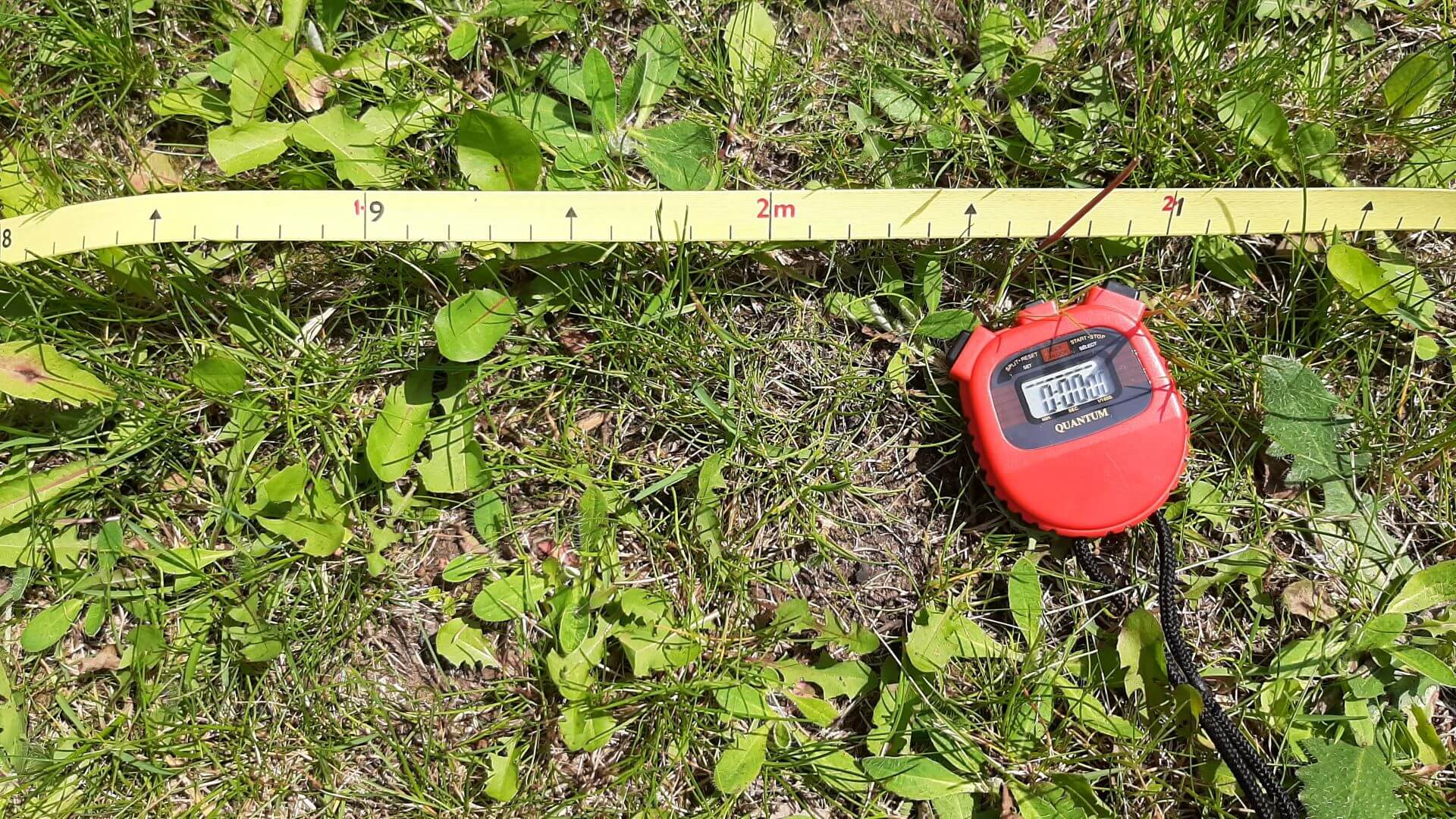
Fitness Testing for Fencing
Fencing is a highly technical sport, however all the blade training in the world will not be enough if your body can’t repeatedly and with control, put your sword in the right place at the right time. Fencing is a full body exercise but it is asymmetric and so it is important to do cross training to ensure all round strength and conditioning.
The following are a series of fitness tests that can be used by fencers to benchmark your fitness particularly when you do not have access to specialist sport science support. The tests have been selected for their relevance to general fitness or fencing specifically whilst requiring little to no equipment or expert input.
Before you start
Before conducting any of the tests it is important that you ‘the athlete’ are properly warmed up, for example with light jogging for 10 minutes. It is essential that you do not start the tests if you have any injury or health condition that could be aggravated by these activities. If you have any concerns, you should seek advice before starting. Make sure that the tests are conducted in a safe space.
‘Focus on personal improvement, not comparisons with others’
The Tests
Resting, maximum and recovery heart rates
Tests: Heart efficiency
How to do it:
- Resting heart rate – Count your pulse for 30 seconds first thing in the morning or after complete rest. Take the number and double it to get a resting heart rate per minute.
- Maximal heart rate – Count your pulse for 30 seconds immediately after maximal effort (e.g. after the beep test). Double it to get the maximum heart rate per minute.
- Recovery Heart Rate – Count your pulse for 30 seconds, 1 minute after taking maximal heart rate per minute.
To take your pulse use three fingers from one hand to feel the pulse in the wrist. Alternatively, a heart rate monitor saves the need to try and find your pulse when exhausted after a maximum effort session!
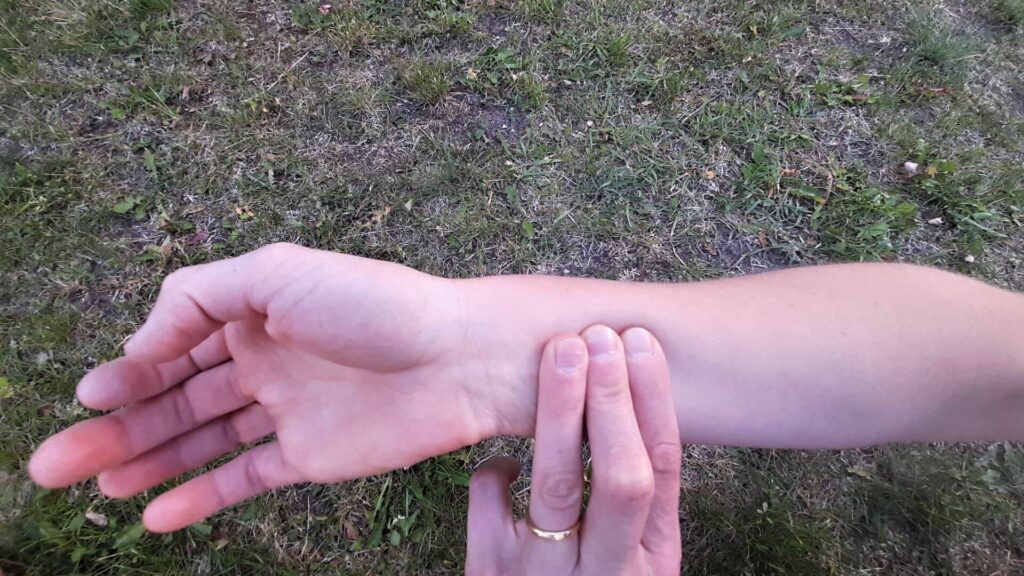
What does good look like?
There is a large range in what is considered a normal resting heart rate with anything between 60-100 beats per minute considered normal. Age, fitness and health all have a large influence on heart rate however generally a lower resting heart rate indicates a more efficient heart function and better fitness. Resting heart rates as low as 40bpm are not uncommon particularly in well trained athletes. An increase in your resting heart rate from what is normal for you can be a good indicator that your body is stressed as with a cold infection and so can be a good signal to ease training.
Maximum heart rate is significantly influenced by age and a good way to estimate your maximum heart rate is to subtract your age from 220. Those new to exercise or wishing to train their cardiovascular system will want to do the majority of their training at an effort resulting in an effort between 50 and 80% of your maximum heart rate.
For sports such as fencing requiring short intense periods of activity followed by a similar or slightly longer period of rest the anaerobic alactic system is utilised. Training for short periods of between 15-30 seconds at a little above 80% heart rate is advised.
Recovery heart rate is a good indicator of how quickly your muscles are able to recover. A faster drop in recovery heart rate indicates that the muscles are making lower demands and are recovering better for the next effort.
Standing Stork Test
Tests: Balance
How to do it:
- The athlete stands on both feet without shoes with their hands on their hips
- The athlete lifts the right leg and places the sole of the right foot against the side of the left kneecap
- The partner gives the command “GO”, starts the stopwatch, and the athlete raises the heel of the left foot to stand on their toes, holding this position for as long as possible
- The partner stops the stopwatch when the athlete’s heel touches the ground, the foot moves away from the knee or the hands leave the hips.
- Record the time
- Repeat on the other leg
- After 3 attempts on each leg, take the best time for each leg and add them together to get a final time.
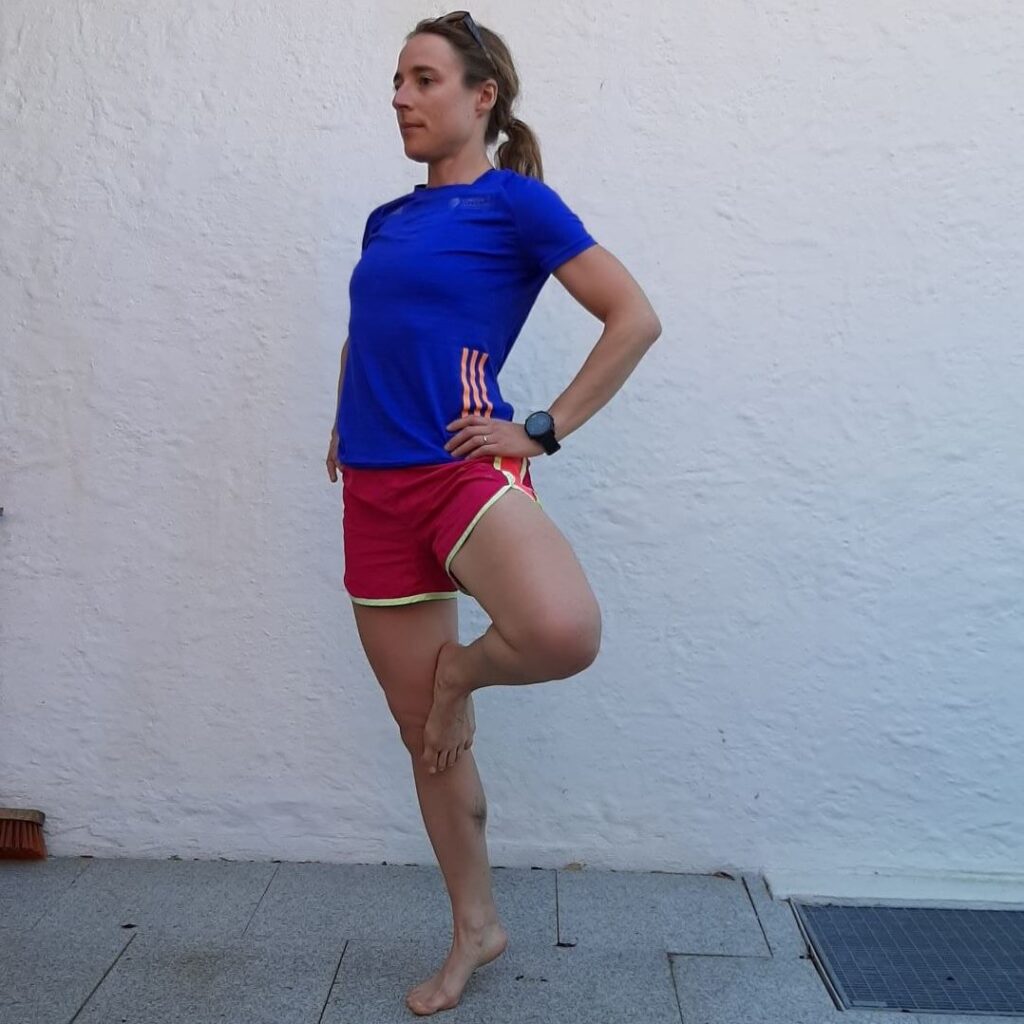
What does good look like?
The times for each leg should be similar. A large difference may suggest weakness and imbalance in the muscles on one side.
A total score of less than 10 seconds is poor. Between 25 and 50 is good and above 50 is excellent.
Lunge length
Tests: Hip flexibility
How to do it:
- Stand on guard and perform a lunge.
- Measure the length from the outside of the rear foot to the heel of the front foot when the athlete is in a full lunge. Ensure that the front knee is directly over the front foot.
- Record the best of three.
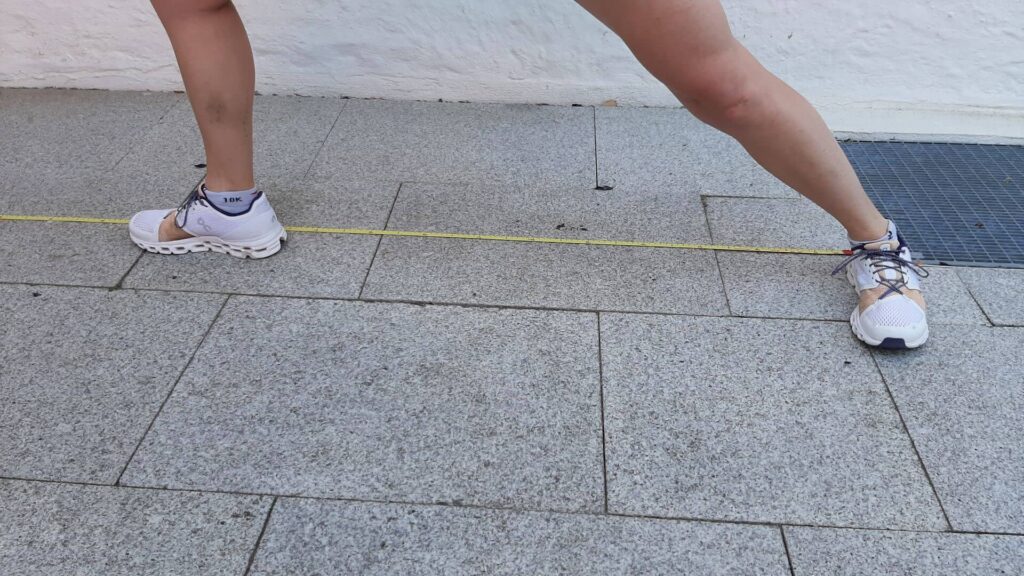
What does good look like?
Lunge length is a factor of leg length, flexibility and body mass and so it is almost impossible to provide a guide to what yours should be. However, a difference between the length of your lunge on the left and the right shows up asymmetric development of muscles and flexibility common in fencers, which can lead to greater injury risk.
An increase in lunge length is a good measure of functional flexibility for fencers. Please note that the power and acceleration generated at the start of the lunge is perhaps more important than overall lunge length and so training for a longer lunge should not be at the expense of power.
Multi-Stage Fitness (Bleep) Test
Tests: Aerobic fitness and a strong indicator of VO2max
How to do it:
- A shuttle run is set up between two lines 20m apart
- A recording is played with beeps. At each new level the interval between the beeps reduces.
- The athlete must reach the opposite line and turn around before the beep.
- If the athlete fails to reach the line before the beep they are issued with a fail attempt.
- When there are two fail attempts in a row, the athlete is withdrawn and the level reached is recorded.
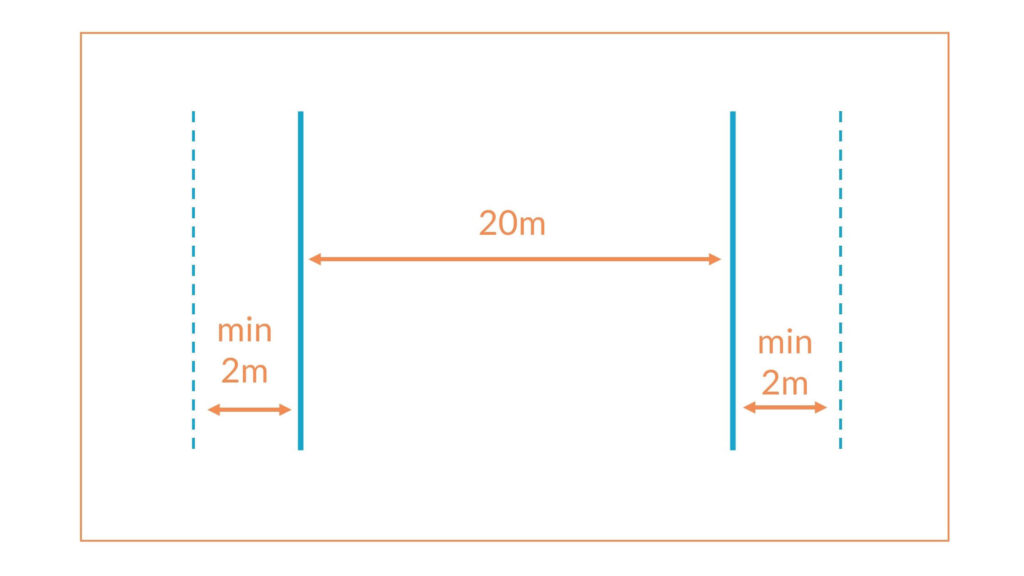
What does good look like?
VO2max is important for endurance and general fitness, however research into international athletes has shown that there is little correlation between fencing performance and VO2 max above 50 (level 10.11), however that is still superior to the general population average. Those under the age of 60 should aim to have a VO2max of at least 35 (level 6.6) and ideally above 40 (level 8.0)
On average VO2 max declines with age and women have a slightly lower VO2max. In the upper ranges genetic factors also put limitations on how much VO2 max can be increased through training. However, like with so many things, the biggest gains can be made by those with a lower baseline.
A good estimate of your VO2 max can be found by comparing your Multi-stage-fitness-test result using a look-up table.
Download the test recording in English >>
Download the test recording in German >>
The test can also be found on the Android and Apple app stores.
Standing broad jump
Tests: Explosive leg power
How to do it:
- Stand with both feet with toes behind the line shoulder width apart.
- Make a single jump as far forwards as possible ideally onto a soft surface such as grass or a sprung floor.
- The jump must be landed without taking further steps forward or backwards.
- Measure from the start line to the back of the heels
- Record the best of three.
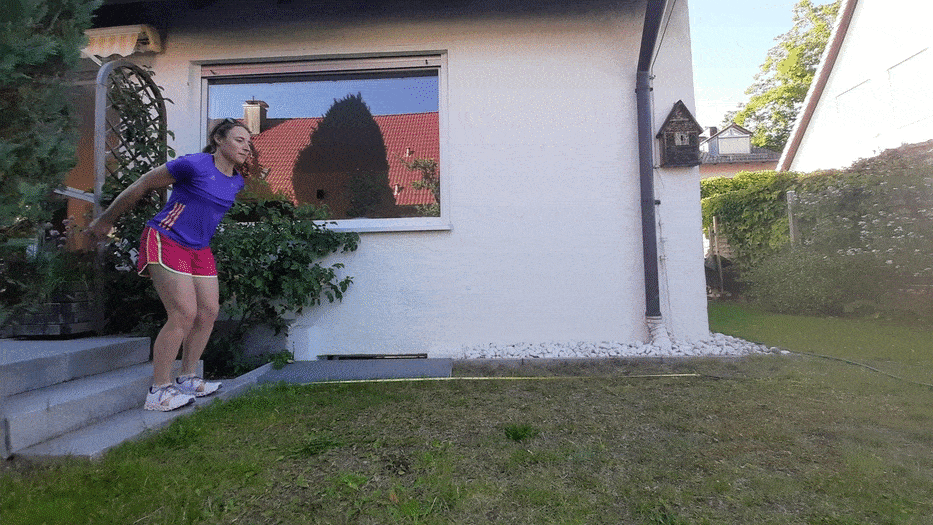
What does good look like?
The world record for the long jump stands at a little over 3.7m however with a standard long jump you do not have to land cleanly on two feet. Landing cleanly will normally reduce the length of the lunge due to the effort required to maintain balance. A good jump for an average male is over 2m and 1.7m for a female.
Plank Complex
Tests: Core strength and stabilisation
How to do it:
- Start in front plank on forearms and hold for 5 seconds
- Transition to left side plank and hold for 5 seconds
- Transition back to front plank and hold for 5 seconds
- Transition to right side plank and hold for 5 seconds before returning to front plank
- Repeat the sequence until good form, with the body in complete alignment, cannot be maintained.
- Record the number of complete sets.
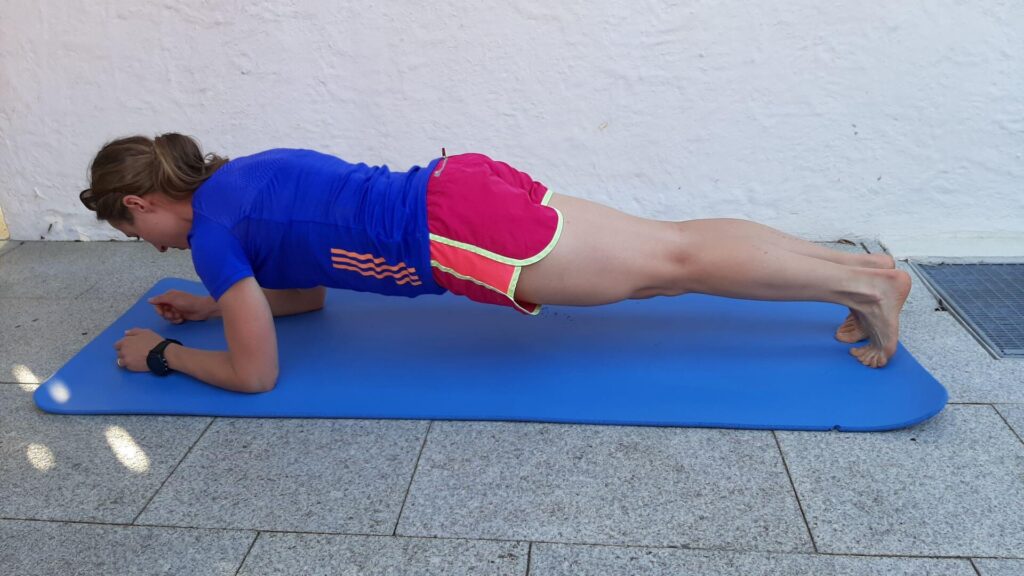
What does good look like?
The world record for a front plank is over eight hours however a good target for a plank is 4 minutes. Since this test involves moving between front and side planks it provides some rest with a wider range of muscles working. 15 complete sets is a good score. Athletes with good core strength should be able to complete in excess of 20 sets.
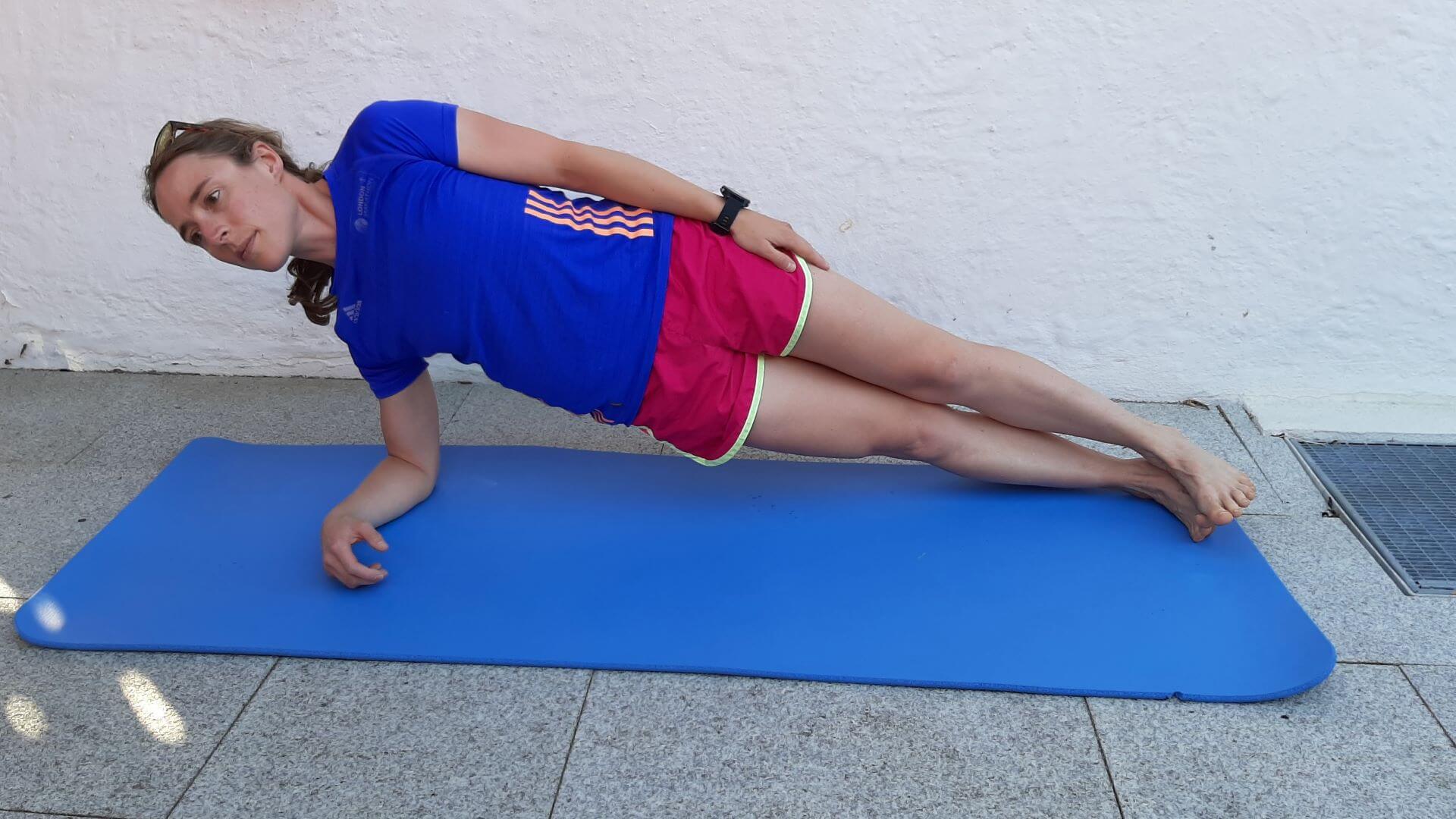
2-4-2 Fencing footwork
Tests: Speed of fencing footwork and change of direction
How to do it:
- A start line, 2 m line and 4 m line should be marked out.
- The athlete will stand on guard with their front foot behind the start line.
- Using correct fencing footwork they advance until the front foot reaches the 2m line
- Retreat until the front foot is behind the start line
- Advance this time to the 4m line then retreat to the start line.
- Advance to the 2m line then retreat again to the start line.
- Record the total time.
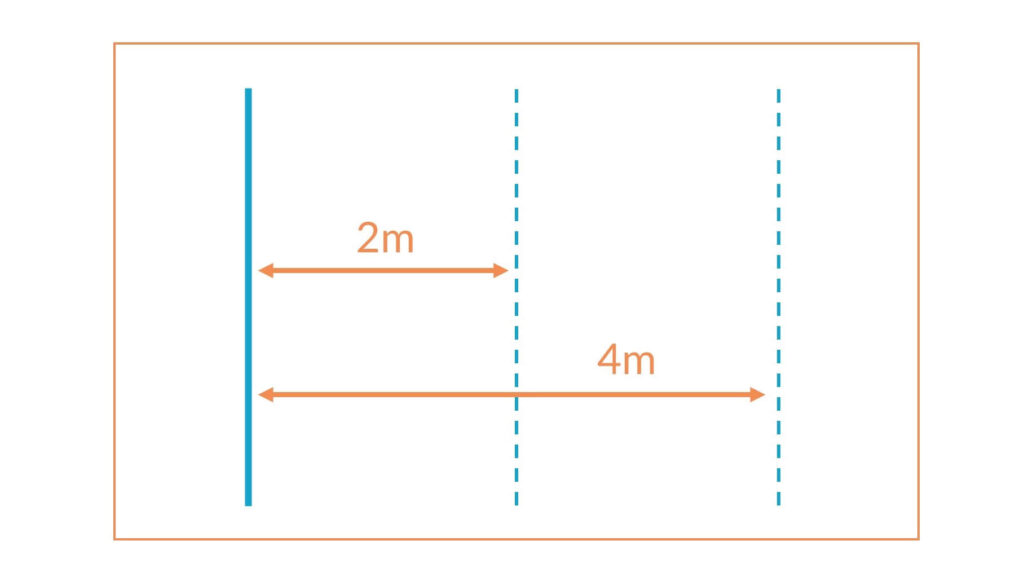
Note: Correct footwork includes keeping the hips level and the upper body in balance, maintaining the ‘on-guard’ distance of the feet between each step and the arms in a relaxed ready position. This test may be conducted with a sword in hand.
What does good look like?
The exercise should be complete in under 10 seconds. 8 seconds is average and under 7 seconds very good.
Squat test
Tests: Leg strength and speed to fatigue over a fencing bout length.
How to do it:
- The athlete stands with feet shoulder width apart.
- Squat until your thighs are parallel to the floor and your knees are in line with your feet.
- Push back up to the starting position.
- Repeat until form cannot be maintained.
- Record the number of completed squats.
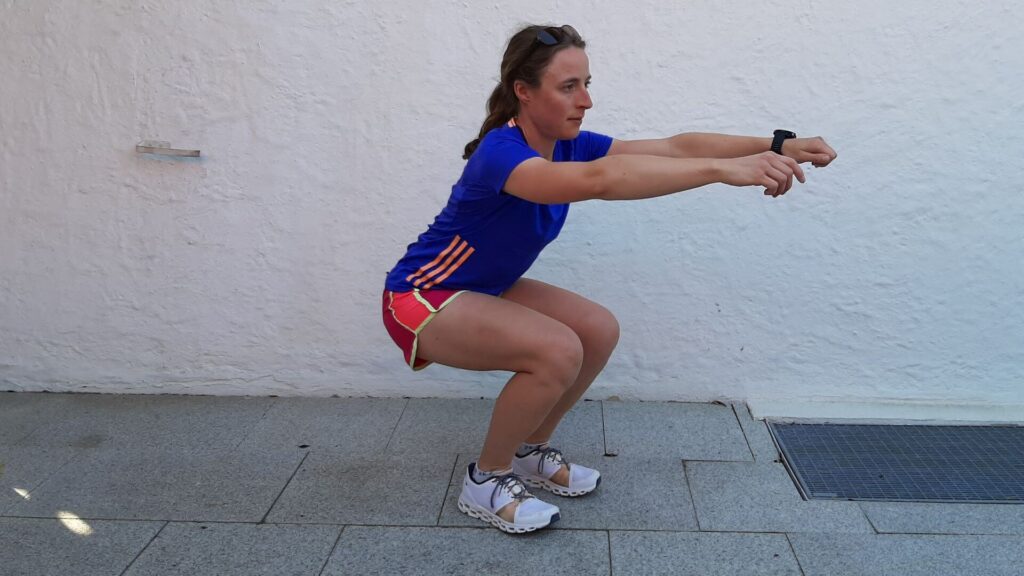
Note: When training, there is evidence that squatting by going through the full range of motion and below the thighs reaching parallel, is beneficial for long term health and injury prevention. For fencers it helps to develop the muscles that decelerate the lunge at the end of the action and enable a faster recovery. However, it is essential that any squat below parallel is done maintaining good form. Since this squat test is carried out with repetitive fast squatting, it is recommended not to go beyond parallel in order to reduce risk of injury.
What does good look like?
Over 50 is good, 100 is excellent.
A similar test, the Sit to Stand test, involves standing from a chair as many times as possible in 30 seconds. For older adults it has been shown to be a very good predictor of falls and functional independence in later life. Anyone under 65 should be able to do at least 15 repetitions in 30 seconds.
Record, Train, Review
These tests have been written in an order that should enable them to be done over the course of approximately 2 hours, with sufficient breaks such that one test has limited effect on the other, however you may choose to do the tests over a couple of weeks.
Don’t forget to record your results from each test and keep them to compare with the next time you do the tests.
You can download this results sheet >>
Once you’ve got baseline information on your fitness, it’s time to train. Perhaps consider creating a training programme. You can find a lot of good information online but it can be hard to choose the best advice and find a plan that meets your circumstances and needs. That’s where your coach or a personal trainer can really help.
These tests themselves can be a good place to start and can form a large part of your fitness training alongside your fencing specific skill training.
After a few months training, it’s time to perform the tests again and review your progress. 3 months is probably a good interval between tests and is long enough for a review to pick up some changes.
Don’t be disheartened if you haven’t improved as much as you would like. Change can take time and a good outcome, particularly as we get older, is holding back decline. If you haven’t made the change you would like, perhaps take a moment to reflect with the following questions:
- Are my expectations realistic?
- Have I done the training I needed to? (It’s easy to do the bits we’re good at and skip the activities we find hard!)
- Have I noticed other improvements in my health and fitness, not measured by the tests.
- What changes do I need to make to my training more effective?
- How committed am I to making the change I want?
References
This guide has been informed by:
Turner A, James N, Dimitriou L, et al. ‘Determinants of Olympic fencing performance and implications for strength and conditioning training’, Journal of Strength and Conditioning Research. 2014;28(10):3001‐3011.
Turner A, Kilduff LP, Marshall GJG, et al. ‘Competition Intensity and Fatigue in Elite Fencing’, Journal of Strength and Conditioning Research. 2017 Nov;31(11):3128-3136
‘Only by taking note of where we were, can we see how far we’ve travelled’
How did you find the tests? What fitness tests do you think are most relevant to fencing? Share your thoughts in the comments below.

0 Comments